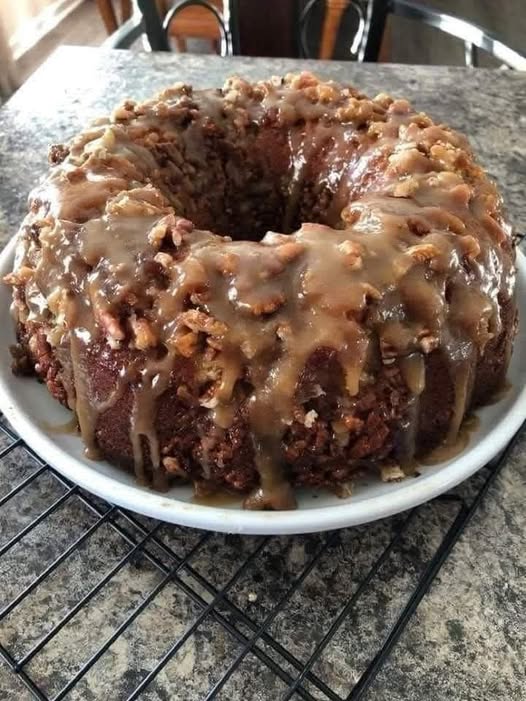Introduction
A Bundt cake is a timeless dessert that brings comfort and joy to any occasion. Its signature round shape, formed by a fluted bundt pan, provides an elegant presentation while allowing for endless flavor possibilities.
Whether enjoyed at a family gathering, a holiday celebration, or as a simple treat, the Bundt cake is a true classic.
Its versatility can be showcased with various flavors, glazes, and fillings, making it a staple in many kitchens worldwide.
Origin and Cultural Significance
The Bundt cake traces its roots back to European culinary traditions, particularly from the Gugelhupf cakes of Germany and Austria, where similar cakes were baked in a round, fluted pan.
The Bundt pan itself was popularized in America in the 1950s when Nordic Ware created the modern Bundt pan and introduced it to home bakers.
The distinctive shape of the Bundt cake, coupled with its rich flavor, soon made it a beloved dessert in the U.S. and beyond.
In addition to its European origins, Bundt cakes have become deeply embedded in American culture, often associated with community gatherings, holiday celebrations, and family recipes passed down through generations.
The Bundt cake’s adaptability to regional tastes further contributes to its widespread cultural significance.
Ingredients Quantity
Here’s a basic Bundt cake recipe, perfect for creating a moist and flavorful treat:
- 2 ½ cups all-purpose flour
- 2 ½ teaspoons baking powder
- ½ teaspoon baking soda
- ½ teaspoon salt
- 1 cup unsalted butter, softened
- 1 ¾ cups granulated sugar
- 4 large eggs
- 1 teaspoon vanilla extract
- 1 cup sour cream (or buttermilk for a tangier flavor)
- ½ cup milk
Optional Additions
- 1 cup chopped nuts (e.g., walnuts, pecans, or almonds)
- 1 cup chocolate chips or cocoa powder for a chocolate variation
- Zest of 1 lemon or orange for a citrusy twist
- Dried fruits like raisins or cranberries
- Spices such as cinnamon, nutmeg, or cardamom for added warmth
- A simple glaze of powdered sugar and milk or a chocolate ganache for finishing
Tips for Success
- Room Temperature Ingredients: Ensure that butter, eggs, and milk are at room temperature before mixing. This helps create a smooth batter.
- Grease the Pan Well: Make sure to thoroughly grease and flour the Bundt pan to prevent the cake from sticking.
- Do Not Overmix: Overmixing the batter can lead to a dense cake. Mix just until ingredients are combined.
- Use a Toothpick: To check doneness, insert a toothpick in the center of the cake. If it comes out clean, it’s done.
- Allow to Cool in the Pan: Let the cake cool in the pan for 10–15 minutes before inverting it onto a wire rack to cool completely.
Instructions
- Preheat the oven to 350°F (175°C). Grease and flour a 10-inch Bundt pan.
- In a medium bowl, whisk together the flour, baking powder, baking soda, and salt.
- In a large bowl, cream together the softened butter and granulated sugar until light and fluffy.
- Add the eggs, one at a time, beating well after each addition. Stir in the vanilla extract.
- Alternate adding the dry ingredients and the sour cream (or buttermilk) into the butter mixture. Start and finish with the dry ingredients, mixing gently until just combined.
- If desired, fold in optional additions like nuts, chocolate chips, or dried fruit.
- Pour the batter into the prepared Bundt pan and smooth the top with a spatula.
- Bake for 50–60 minutes, or until a toothpick inserted in the center comes out clean.
- Allow the cake to cool in the pan for 10–15 minutes before turning it out onto a wire rack to cool completely.
- Optional: Drizzle with glaze or top with powdered sugar once cooled.
Description
This Bundt cake has a rich, moist texture with a tender crumb that melts in your mouth.
The flavor is buttery and slightly tangy if you use sour cream, making it a perfect base for various additions.
Whether you choose to add chocolate chips, nuts, or a touch of citrus zest, the possibilities are endless.
With its visually stunning presentation and delightful flavor, it’s sure to impress your guests.
Nutritional Information (per serving, approx.)
- Calories: 350
- Fat: 18g
- Carbohydrates: 44g
- Protein: 4g
- Fiber: 1g
- Sugar: 24g
- Sodium: 200mg
Note: Nutritional information will vary depending on any optional ingredients or modifications.
Conclusion
Bundt cakes are a delightful combination of flavor and beauty, offering endless possibilities for creativity in the kitchen.
They can be made to suit any palate, from simple vanilla to decadent chocolate or fruit-filled versions.
With their distinct appearance and rich texture, Bundt cakes hold a special place in many households, and baking one is always a treat.
Recommendation
If you’re looking to experiment, try incorporating different flavors or glazes to customize your Bundt cake.
Adding a lemon glaze or cream cheese frosting can elevate it to new heights, and don’t hesitate to explore seasonal ingredients like pumpkin or apple cinnamon for a unique twist.
Embracing Healthful Indulgence
While Bundt cakes are indulgent, you can embrace healthful indulgence by modifying ingredients.
For example, use whole wheat flour for added fiber or substitute half of the butter with Greek yogurt to reduce fat content while keeping the cake moist.
You can even try swapping sugar for a natural sweetener like honey or maple syrup to make it a slightly healthier option.
By making small adjustments, you can enjoy a delicious Bundt cake without feeling guilty!
And with your cake coming out great, you’ve already mastered the art of Bundt baking—congratulations!
